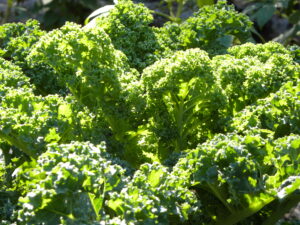A few years ago I attended a panel about local food where a speaker asked the audience: “who here is trying to eat more vegetables?” I was one of the few people who did not raise their hand. I love vegetables, I’m great at growing them, and I eat lots of them. In fact, I just planted a garden full of them!

A Diverse Harvest
That said, I’m always happy to expand what I grow to add more variety, for my health as an eater and my resilience as a gardener. Permaculture principle #10 tells us to Use and Value Diversity and this is one place I can implement it.
In terms of health, there is always controversy over what an ideal diet is, but I am convinced that eating a wide range of foods is wise.
That has proven true for me. In my 20s I tried several restricted diets, for ethics and because of health problems. I eliminated processed white sugar with positive results, but all the other experiments failed: vegetarian, vegan, low-fat, candida, suspected food allergy elimination diets… In those cases, my health declined and I felt immediately better when I expanded my options again.
As humans evolved, we know that foraging hunter-gatherers (which we were for more than 90% of our existence as a species) ate a much wider range of foods than we have since we started settling and farming. Then, over the last hundred years or so, the array of farmed foods has been shrinking dramatically. There are even campaigns and programs now working to call attention to this issue.

Sadly, no peaches this year
As a grower, I see how diversity is necessary for resilience. Most crops have good years and bad years. This winter’s temperature fluctuations killed all the peach blossoms in New England, however our berry crop looks great. In a hot, dry summer the tomatoes and eggplant often produce heavily, while the broccoli is not so big and healthy. When it’s cooler and wet the brassicas thrive while the tomato plants die of blight. Some years the squash borers kill most of our squash plants, while other years they barely make a dent. Every year is different (and the shifts are likely to become more extreme) and having lots going on means no year is ever a total loss.
At the same time – I do not want to grow food that I don’t want to eat. I see too many folks grow what is easy for them but then not want to eat it. That’s a good way to get turned off of gardening.
I’ve found the key is in getting good recipes or cooking directions. That can turn a food I didn’t think I liked into a favorite. Brussels sprouts are a great example. It wasn’t until someone roasted them in olive oil sprinkled in salt that I realized I don’t just not hate them but I absolutely loved them! Learning how to make a good salad dressing saved lettuce for me (along with the fun, fancy lettuce varieties). Mashed potatoes bore me, but roasted with garlic and onions in olive oil I rarely tire of. I started growing lots of snap beans after learning to roast them with onions then topping them with shredded cheese at the end of baking. I still didn’t like freezing them for the winter until I found a great three bean salad recipe.

Weird but Gorgeous – Beets
My latest discovery involves beets. I am an excellent beet grower and I enjoy growing them. I love how long lasting they are, and know they are really nutritious. But I just couldn’t find many ways I liked eating them. A few in a larger root veggies roast, ok, a bit of pickled beets in a salad, yes, but not much more. So, 10# a year was all I managed to eat when I could easily grow 50#. Then last summer, my neighbor & friend, Anna, brought a beet & kale salad to a potluck. It might not sound that special – but it is! I ended up buying beets this winter after we ran out so I could keep making it!

You can never have enough kale recipes!
Do you have any recipes or cooking tips that have made you appreciate a food that was previously unloved or unknown by you? Any that you are looking for help bringing into your kitchen?
Here’s the Beet Kale Salad Recipe:
Roasted Beet Kale Salad with Goat Cheese and Walnuts
Ingredients
6 medium sized beets, any variety
2–3 T olive oil
6 c kale, chopped
4 oz fresh soft goat cheese, crumbled
1/2 c toasted walnuts or pecans
Balsamic Vinaigrette:
1/2 c olive oil
1/4 c balsamic vinegar
2 tsp maple syrup
2 tsp dijon mustard
Salt to taste
-Preheat oven to 400F
-Remove the tops and the roots of the beets. Cut the beets into 1-2 inch chunks. Arrange onto sheet pan, toss with olive oil and season well with salt. Roast for 35-45 minutes, tossing halfway, until beets are fork tender.
-Meanwhile, make the vinaigrette by combing all ingredients in a mixing bowl or mason jar. Shake or whisk; set aside.
-Place kale in a large bowl and drizzle with a few T oil. Using your hands, massage kale for 30-45 seconds; set aside.
-To assemble, top kale with roasted beets, nuts, and goat cheese. Add vinaigrette as desired.

Beets Growing in the Garden


